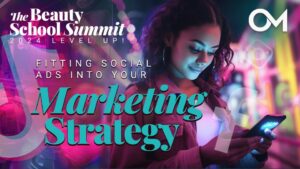Fitting Social Ads into Your Marketing Strategy
Chelsea Owens
Social Ads Manager, Oozle Media
Video not loading? Click here to watch.
Chelsea Owens:
Oh, thanks for that intro, Chris. Appreciate it. Let me start sharing my screen with you guys here. Awesome. So like Chris said, my topic today is fitting social ads into your marketing strategy. And let’s see, I got to make sure I’ve got this all set up. Awesome. So this is the same intro that Chris just read. Like he said, I have been working here at Oozle for four and a half years and I’ve loved it. I’m essentially the resident social media guru. My specialty is in paid social ads for the most part, but I’m starting to dabble in the organic side again, which has been good so far and hopefully continuing to get better. And yeah, I am at the University of Utah right now getting my MBA and I actually graduate next week, which is super exciting and very excited to be done and just to have accomplished that. So very exciting.
And then I coach high school lacrosse on the side from my alma mater. So good times. Me and my husband love to spend time in the outdoors and the Utah Mountains as well, and just having a great time in our lives.
So last year, if any of you guys were there to listen to my presentation, we talked specifically on TikTok advertising and we kind delved into the details of that. But this year I kind of decided to talk about the broader spectrum of paid social advertising.
The Marketing Funnel
So let’s get started. Let’s look at what our digital marketing funnel looks like first and how paid social fits into that. If you aren’t familiar with the digital marketing funnel, here’s kind of a brief synopsis. It’s essentially our consumer journey from meeting us to then becoming our loyal customers, our students, in your case. So at the top we’ve got brand awareness, people are meeting us for the first time, and that’s kind of where we hit everyone in the organic phase of our marketing strategy. Organic social media, blogs on our websites, SEO, those sort of things.
And then we move into the consideration phase, which is where I’ve placed paid social ads. This is where after we’ve met people, now they can kind of say, “Hey, I would like to get to know you a little bit better and learn more about your programs and your services, what you have to offer.”
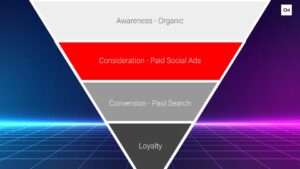
And then moving further down into the funnel, conversions, that’s where we’ve put paid search. And you guys listened to my colleague Dave Steiner before, and you’ll listen to Patrick right after me. We’ve kind of done a reverse funnel in our lineup here.
And then after paid search, you’ll go down into that loyalty phase. They’re enrolling in your school, and maybe they even come back to be educators for your school.
Where Paid Social Ads Fit Into the Funnel
So let’s talk about the paid social ads and how it fits into this consideration phase of our digital marketing funnel. Within this area, social ads kind of has their own marketing funnel. We have that awareness phase at the top. We have our traffic in the middle. We want to send people to our website there. And then we have conversions, lead generation. So today we’re going to touch on five of the social platforms that we at Oozle love to use, starting with TikTok. So like I said, last year we talked in detail about TikTok, but today we’ll just touch on it briefly. So I’ve placed TikTok at the top of my funnel. Now TikTok has become one of the most popular social media platforms that people talk about.
We see a lot of TikTok videos end up on other platforms. It’s such a great place for people to meet us for the first time. This is a great platform if we are wanting our videos to go viral or whatever the case might be, we just want to get our face in front of someone and TikTok really is that place to go.
TikTok
Now, TikTok is an entertainment platform, so people are going on there to take a break in their day and they’re just kind of mindlessly scrolling it. That’s what I do on TikTok. I’m not there to be asked to take action by any means. I’m really there just to kind of let my mind take a break. And so that’s kind of why we put it in that top part of the funnel rather than the bottom. So I want to talk about a few facts that I found about TikTok from one of their recent presentations. So let’s go through these quick facts really fast and you’ll understand why I’ve described it as a discovery engine up here at the top.
So this first one, it says, intriguing narrative structures guide viewers pass the first few seconds, ads intended to make users curious, keep them watching 1.4 times longer. And then this is a quote from chief creator officer at Whaler.
“Remember, this isn’t tv, it’s culture. It means that your brand is now stepping into a creator’s space. You have to look and feel like that. The instant you try to script it’s over.”
This one says users are 1.8 times more likely to agree that TikTok introduces them to new topics they didn’t even know they would like. 40% on TikTok versus 22% on traditional social media. And then this last one, there’s a few statistics on here. After seeing an ad on TikTok, 41% of viewers trust the brand more. 31% are more likely to be loyal to the brand, and 33% are more likely to say the brand is a good fit for who they are as a person versus before seeing ads on TikTok.
So these little key facts here are kind of proving this point that TikTok truly is a discovery engine where people want to be introduced to something new continuously and they want to be able to connect and feel like someone’s relating to them. And that’s why we’ve kind of put TikTok at that top part of our funnel. And TikTok is just so prominent today that we don’t want to ignore it.
SnapChat
All right, in the consideration phase of our funnel, I just want to briefly touch on these two platforms. Snapchat is a messaging platform where we can keep in touch with our friends and family. I have recently learned from my lacrosse players that it is a loophole into asking for someone’s number when it comes to dating. So that works there as well. Once people have cleared out their inbox on Snapchat, it’s a great place for… It’s essentially a news board. People are there to learn new things, so they’re more likely to be okay with being interrupted in their social media time on this app to go and visit a website to learn more. So that’s kind of where our businesses come into play.
LinkedIn is similar, however, it’s a business to business platform. So we need to be careful about how we’re advertising there and spending our marketing dollars. But if you’re looking for new educators at your school, LinkedIn is the best place for that. And again, it’s a news board and so people are willing to leave and go learn something because they’re already there looking to learn something new.
Meta: Facebook & Instagram
All right, the bottom of our funnel is Meta, Facebook and Instagram platforms. Meta is the biggest platform worldwide right now, and there is a reason that we see a lot more people taking action through these platforms and I’ll tell you why. I want to spend a little bit of extra time in this area to kind of just prove my point.
These are some advantages for both of these different platforms. With Facebook, we have an opportunity to join groups and communities. So within the beauty school industry, we can join local communities and beauty and kind of get to know what’s trending around us and what we need to keep up on. It really is a great business platform, even just organically,
- keeping up on our business pages and informing the community about events we’re having
- specials and start dates
- great messaging platform with our loved ones, our friends and our family.
- It has a variety of entertainment options, posting video, photo
- looking on there for news
- going to shop, buying and selling things in the community
- And you can even play games on Facebook, which is really interesting.
- And lastly, it’s a search engine.
Something really cool that’s just rolled out with Meta is their new AI search. So you can now actually interact with an AI bot on Meta platforms, both Facebook and Instagram if you have something in mind that you’re looking for answers. And then on the Instagram side, similar idea, but maybe a little bit more simplified, super easy way to share photos and videos with your friends and family. It’s honestly my preferred choice of social media these days. It’s a great shopping platform and obviously messaging with loved ones and another great entertainment platform.
So, my point in addressing these advantages of Facebook and Instagram is that people are going onto these platforms for specific reasons outside of just being entertained. They’re going onto these platforms with a purpose half of the time. So people are much more likely to take some kind of action where they’re essentially committing to your business or your school.
Whereas TikTok, they don’t want to commit to you yet. They just met you for the most part. Snapchat and LinkedIn, they’re just getting to know you. And now Facebook and Instagram, there’s potential. They’re searching for you or they have seen you before. So once you come up again, they’re willing to submit their information to you.
Facebook: The Top Social Platform
So moving forward, before I go to the next slide, a lot of you guys like to tell me that your audience is not on Facebook yet or anymore. They’re not there anymore because they’re only on Instagram and TikTok. So I want to convince you otherwise really fast if you’ll stay with me, let’s look at a few statistics as to why you should be advertising and spending your marketing dollars on Facebook specifically. So Facebook is still the most used social media platform as of January of this year. You can see it on this bar graph. LinkedIn is not on here because it’s kind of a niche platform for working professionals, but in the space that we’re trying to market in, it is still far beyond these other platforms in terms of users.
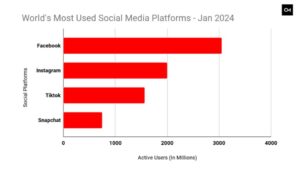
Yes, Facebook is still relevant. So 3.05 billion active users on Facebook. Facebook’s global advertising audience is made up of 2.25 billion users as of April of last year. Facebook’s monthly active users are 37.2% of the global population, which is kind of crazy. That’s a lot of people. Facebook, you have the opportunity to hit both B2B and B2C marketing, which is kind of hard to do on all platforms.
And I found an e-marketer study that said that 96% of social media marketers say that Facebook is the most effective social media ad platform, and I happen to agree with them.
So if you still aren’t convinced, this is my last effort to get you on my side here.
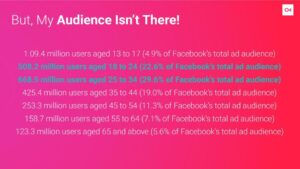
So if you still think your audience isn’t there, well with the beauty schools, we know your age demographic is between 18 and 35 and 18 to 35 year olds make up over 50% of Facebook’s total ad audience. So I hope this is convincing you here. This is where we need to be if our true objective with social advertising and putting money into social advertising is to get leads and conversions, this is where we should be focused. If anything, at least to run a top funnel campaign on Facebook to gather as much people into our audience as possible and remarket them on other platforms. So that’s our goal here.
I want to go back now to the beginning of my presentation where we started with the holistic digital marketing funnel. So let’s connect the dots and talk about social ads fit into our overall strategy. So this is our bridge. We start on one side of the bridge with organic marketing. We are writing blogs, we are posting on social media organically. We’re doing what we need to with our SEO, right? But how do we get people who have seen this and interacted with our social media and our website to now go searching for us through Google? That is exactly where paid social comes into play. We can put money behind those organic social posts to push out to more people. So people who have interacted with us before or maybe we’re trying to just expand that audience a little bit bigger just to say, “Hi, nice to meet you.”
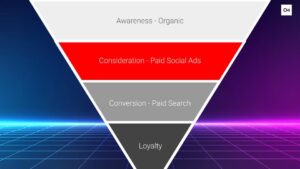
And then we trickle them down our social ads funnel, whether they convert on social ads or not. Then this is our last effort is paid search. So they’ve seen us organically, they’ve seen us through paid sponsorship on social ads, and I think they’re ready to commit. They’re ready to search for us. And that is how we’re getting over that bridge from organic to paid search to PPC.
And that’s kind of all I have to talk to you about today. I know this was a very broad kind of talk, but that’s exactly what my goal was, was to get you guys to understand how paid social ads fits into the holistic marketing strategy. And if you guys ever want to talk specifics with me and we can kind of nail down a strategy for you, my email is right here in the bottom right corner. Feel free to reach out and I’m happy to talk to you. And I think we have a little time for Q&A here.
Chris Linford:
Yeah, thanks, Chelsea. If you have questions for her, put them in the chat. But hey, I think it might be shocking for a lot of people to be like, oh my gosh, there’s still a demographic on Facebook and you backed it up by data. What does your lead data tell you? Working with so many schools across the country, advertising in Meta, on Snapchat and schools always want the leads. Does Facebook and Meta still just dominate for quality leads out of all the social media platforms? What do you see?
Chelsea Owens:
Absolutely. I can think of one client that actually was performing on almost all of these platforms. They were on Meta or Facebook, Instagram, TikTok and Snapchat. And we were seeing leads come in for all of them and their TikTok account was pulling in, I don’t know, 50 to 75 leads a month. But once we kind of deduped them and kind of went through the quality of those leads, Meta always came out on top with the lead to enrollment rate, with the number of leads. And while it all should be working together, I think if you really are wanting to see conversions out of your social ads dollars, definitely put some of that into Facebook and Instagram for sure.
Chris Linford:
Got it. We’ve got some questions in the chat. One question was about video versus just posts and engagement. What do you see in there?
Chelsea Owens:
I would definitely say videos are dominating these days. And video, you can put them across all platforms. That’s what’s so great is that we can redistribute our content that we make across all platforms, especially video because TikTok only takes video. So that’s so great about video. I would still include still images and still ads into your mix just so that you can kind of A/B test against those things. But videos are most engaging and get people hooked on what you have to offer them, for sure.
Chris Linford:
And even if you just have stills, mashing them together and creating a video out of it, right?
Chelsea Owens:
Yes, totally. And we do that at Oozle a lot where we will just make slideshow ads of the still images that clients will send us. Maybe they don’t have time to shoot video, but we can make a moving picture at least.
Chris Linford:
Right. There was a question on YouTube, thoughts on that? I think that might be a great question for the marketing panel, Parker. Oh, it’s already been sent to the panelists. And then there was a question by Gabby. What are your recommendations on focusing on a TikTok strategy given the current news of a possible ban? Our school currently does not have a presence on that platform.
Chelsea Owens:
To be honest with you. I think we don’t know what’s going to happen yet fully. And so in my opinion, you got to just keep using your marketing as if nothing was going to happen because people aren’t going to stop using the platform until it’s official. And so if you’re not on it yet, it’s not a bad idea to at least get started so that say the ban is not a thing anymore, you’re at least started and you’re ready to go and ready to continue forward with that strategy.
Chris Linford:
And I would add to that, even though you may not be on TikTok as a school, your students are. Create a business page and you can put money behind your students’ content and use those for your ads on TikTok. So even if you are not creating content, your students are, and you can still use that on the platform.
Chelsea Owens:
Yes. Go watch my presentation from last year that was all about TikTok and their Spark Ads product. So go check that out.
Chris Linford:
Yeah. And if you want to check that out, if you just scroll up a little bit, we have a link to your presentation from last year on TikTok. So yeah, check that out.
Chelsea, thanks so much for being with us. Always great content. This will be on demand for everybody in a few weeks, potentially on our website. So yeah, share it with others and we’re happy for everyone who’s joining us.

